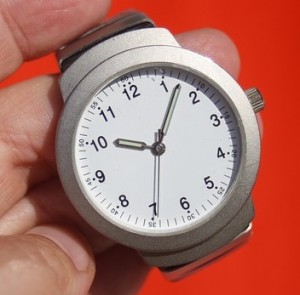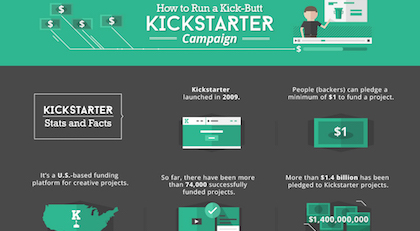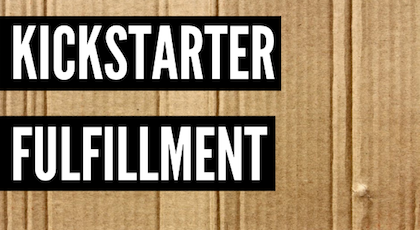 This is a guest post by Elena Mikhaylova, the CEO of CrowdfundProductions, a company that puts on crowdfunding events and helps entrepreneurs launch crowdfunding campaigns.
This is a guest post by Elena Mikhaylova, the CEO of CrowdfundProductions, a company that puts on crowdfunding events and helps entrepreneurs launch crowdfunding campaigns.
Crowdfunding has become a well known venue for raising money for games and gadgets. However, it is also a great fundraising and marketing tool for publishers, fashion designers, restorators and other innovators.
In this column we are going to meet with people who successfully crowdfunded their products and businesses in less mainstream categories. The first meeing is devoted to the “Food” category. So join our friendly gathering and get ready to learn and feel hungry. Let me introduce you our guests.
We Interviewed 7 Successful Creators
Adrienne McNicholas and Michelle Ivankovic from Food Huggers, reusable silicone food savers company in San Francisco, CA, have convinced 5,414 people to support their project and collectively pledge $183,497.
Catt White and Dale Steele funded repairs of a Market Hall in San Diego Public Market with $146,121 raised from almost 1,400 people.
Dina Falconi and Wendy Hollender from Accord, NY have raised more than $115,000 from 2,315 backers to publish their book Foraging & Feasting: A Field Guide and Wild Food Cookbook.
Natalia Rodriguez and Allen Gomberg from Miami, FL funded creation of their company Jiva Cubes with support of more than 3,000 backers who pledged over $103,000 for their two Kickstarter campaigns.
Sergy Yurkin from Port Washington, NY is running his third Kickstarter campaign for his cheese snacks company. He raised over $27,000 last time and now hopes to exceed his funding goal of $20,000 by the beginning of June.
Zack Jordan from Chicago, IL has a background in game design and started his Kickstarter campaign to test his knowledge of crowdfunding. As a result, he has funded his spices company with $26,034 from more than 600 supporters.
Will White from Denver, CO funded his Caveman Cafeteria raising over $21,000 from 344 paleo diet fans.
Below, we’ve asked these creators a series of questions to give you a behind-the-scenes look at their successful Kickstarter campaigns. Feel free to skip to the section that is most relevant to you and if you find this article to be helpful, leave a comment letting us know!
Why did you decide to launch a Kickstarter campaign?
Natalia Rodriguez and Allen Gomberg: At the time, we were both broke college students and we needed a way to raise funding to bring JivaCubes into the the US. We heard of Kickstarter’s success in 2012 and thought it was a great way to gauge public interest in the product and also fund our first production run.
Note: Unfortunately, the first attempt wasn’t successful. The team raised less than $4,000 of their $15,000 goal from 74 people, and since Kickstarer is an all-or-nothing fundraising platform, they didn’t receive any funds.
However, the team was not ready to give up. Less than a month later Natalia and Allan started the second campaign with a very low goal of $1,000. This time they were successful, raising $21,173 from 690 backers.
Their third campaign was launched seven months later and brought them $82,012 (out of a $15,000 goal) in funds from 2,768 supporters.
Catt White: We used Kickstarter to fund the initial clean up and repair of Market Hall at the San Diego Public Market so we could use it for a farmers’ market and other events. We had undertaken a large project and wanted to get one piece of it into operation so the community could start to connect with the neighborhood, while we worked on the larger issues. Kickstarter gave us a chance to judge community interest as well as raising a first round of funds.
Zack Jordan: I’m a game designer by trade, and I got interested in Kickstarter when some interesting games began showing up on the platform. I backed a few, and then I began thinking about doing it myself, or maybe researching it and writing a short book on how it’s done. By the end of my research I thought a good test would be to run a campaign myself. That would tell me whether I’d mastered the principles behind crowdfunding success.
Will White: We started out with a food truck to get our name out there and the truck had constanct mechanical problems. I decided to raise funds to build a trailer that would be more reliable.
Sergy Yurkin: During our visits to Russia, Armenia, and the Central Asian Region we had the pleasure of enjoying Chechil in most restaurants and bars. Once we tried it, we could not get enough of it! That’s how our Kickstarter campaign was born. We have raised $27,000. Now we are running our third campaign, Cheese Bites, trying to raise $20,000 to bring a snack that not only pairs great with beer but just about anything.
Adrienne McNicholas and Michelle Ivankovic: We both have experience developing and launching new products for clients. We had been interested in trying Kickstarter as a different way to bring a product to market for a while. When the Food Hugger design came around, we felt like we had a product that was a good fit for crowd funding and decided to test the waters or launching a product ourselves.
Dina Falconi and Wendy Hollender: We decided to use Kickstarter to fund our project because we thought it would be a great way to spread the word about our book directly to viewers — it’s a wonderful PR tool. We also wanted to self publish. Through our campaign, we presold about 3,000 copies of our book which allowed us to fund our first printing of Foraging & Feasting: A Field Guide and Wild Food Cookbook and to establish our publishing company Botanical Arts Press.
Key Takeaways: Starting a Kickstarter campaign can be a great way to test the marketplace’s receptiveness to your product, attract media attention, connect with a larger community, and raise funds for a project.
Why did you fail and what did you do differently later that changed the outcome?
Two of our guests experienced Kickstarter failures. Hear what they say about recovering from crowdfunding failure below.
Sergy: Our first campaign was not successful. I think we asked for too much ($27,000) with not enough preparation.
Natalia and Allan: The problem with our first campaign is that were very foolish. We did not do any research prior to launching our campaign. We thought we could just throw our project up on Kickstarter and it would take care of getting us all our backers. What we noticed is that Kickstarter is all about momentum. You need initial backers to back you or your project will hardly be seen.
Kickstarter is all about momentum. You need initial backers to back you or your project will hardly be seen.
During our first campaign, we did not have any kind of community. In order to even see our project, you had to click the Food section, then you had to click ‘See more projects’, and then you had to scroll past 30-50 projects. Chances are that any would-be backer was diverted by another interesting project.
When we launched the second project, our former backers actually backed us, which gave us much more visibility on the website. This exposure caused much more people to back our project and this allowed us to be one of the most popular food projects. That means when people clicked the food category, they would likely see our project. This allowed us to raise more money than we originally asked for in the first campaign.
 Will: We had about 3k likes on FB and 1k followers on twitter and both those #s doubled roughly by the end of the campaign.
Will: We had about 3k likes on FB and 1k followers on twitter and both those #s doubled roughly by the end of the campaign.
Zack: Since it was a brand new project, I started the Facebook page at the same time as the campaign: so, zero fans. Same with Twitter, Instagram, etc. By the end of the campaign, Facebook was up to 9,000 followers, plus I had built a mailing list of 25,000 people.
Adrienne and Michelle: We each had personal networks on Facebook that we used in the first days of the campaign. Before we launched the Kickstarter campaign Food Huggers only had 30 “likes” on Facebook and no Twitter followers. Now we have 6,800 Facebook followers and a growing audience on Pinterest, Instagram and Twitter.
Dina and Wendy: The size of our social network was a combination of Wendy’s more computer savvy reality (1,000+ email list) and my (Dina) diligently working to get that network up and running. A few months before the launch I did homework and gathered contacts (1000+). When we launched we sent it out to 2000+ contacts. We began a Facebook page at that time. Now we have 4500 contacts and a FB page with over 3700 likes.
How much time did you spend on preparation of the campaign?
 Natalia and Allen: We spent a few weeks researching what successful projects had in common and trying to learn from the mistakes of failed projects. We found great advice on Quora. CrowdCrux also has a wealth of useful information that is well-organized. Once we had a decent idea of what makes a good project, we spent the next 2 weeks working on our video, pictures, and copy.
Natalia and Allen: We spent a few weeks researching what successful projects had in common and trying to learn from the mistakes of failed projects. We found great advice on Quora. CrowdCrux also has a wealth of useful information that is well-organized. Once we had a decent idea of what makes a good project, we spent the next 2 weeks working on our video, pictures, and copy.
Sergy: Since it was our third campaign we had spent about 2-3 weeks on preparation. However it took much longer for our initial project.
Will: I spent less than a week, including filming and editing the video.
Zack: I spent about a month in research and a month creating the product and setting up the video shoot.
Adrienne and Michelle: We spent about three and a half months before the campaign started and we have been full time since.
Dina and Wendy: We probably put in 6 weeks of prep time for the campaign itself: video, visuals, etc. and 3.5 years to write a book.
Catt: Approximately 3 weeks of analysis, writing story and producing video.
What, in your opinion, was the most productive or useful action you took during your campaign?
Natalia and Allen: Research tips for running Kickstarter campaigns. There is so many questions being answered by successful project creators and others that give very interesting insights on things you need to focus on for your project. A week of research led us to understand the components of a successful Kickstarter project.
Will: Gorilla marketing. Cook samples of food at events where you target market is present and get their email. Send them a link to the campaign.
Zack: RESEARCH. There is really no substitute for it. Successful Kickstarters follow a pattern; if you can follow that pattern, you can successfully fund your project. However, you’re not looking for what everybody else did right or wrong. You’re finding out what all those successes and failures say about potential backers’ desires. If you know what people want, you can give it to them.
Sal’s Note: I highly recommend checking out our article on How to Research Kickstarter Campaigns. It introduces a lot of free tools and techniques.
Adrienne and Michelle: We put out a lot of updates and we kept our backers really well informed and closely connected to the project. We wanted to be sure they felt included in the process and knew we appreciated them.
Dina and Wendy: We took the time to develop a really good product, something that we were proud of and that we thought the world would appreciate. We also feel a good video makes a huge contribution to an effective KS campaign.
Catt: We had a lot of our skin in the game before we started, told a good story, and kept it visible throughout the campaign with regular updates to both KS and social media.
Did you hire any specialists (consultants, PR agency, videographer)? If so, how much of your success was because of their help?
 Natalia and Allen: No. I don’t know if we’d hire a PR agency for a Kickstarter campaign unless they have a proven track record focused specifically on Kickstarter. Find out who their clients are and email them to find out their experience.
Natalia and Allen: No. I don’t know if we’d hire a PR agency for a Kickstarter campaign unless they have a proven track record focused specifically on Kickstarter. Find out who their clients are and email them to find out their experience.
Be careful because you could spend a lot of money and not see any results. We learned that it was important for us to do the marketing for our company so that we really understand who our customer is and where our customers are.
We did hire a videographer, who happened to be a really good friend of ours. We believe the wonderful job she did on our video was a huge factor in our success. We are about to launch another Kickstarter and you can bet your ass she is the one doing the video.
Sergy: No.
Will: No.
Zack: I hired a video crew and a chef, and the Kickstarter video was just twenty friends having a foodie party. Having a real expert (e.g. a chef) vouch for your product adds a lot of credibility, as does having a video that looks like it wasn’t shot on a camera phone. People still mention that video to this day, so apparently it was effective.
Catt: We used videographers, and they did a great job.
Adrienne and Michelle: We did hire a PR agency after the first week and saw a big difference in the level of coverage we got. Working with a pro in media coverage is a big advantage. We were lucky that Adrienne’s boyfriend is a photographer and videographer and was able to work with us to shoot the video.
Dina and Wendy: We hired my son Sam Falconi as videographer and his contribution was immense. Yes, a good video makes a huge difference.
Key Takeaway: If nothing else, invest your time, energy, and money in a good video.
How much did you raise during first three days?
Natalia and Allen: Almost 70% of the goal
Sergy: A little over 25% of our goal
Will: 25% of our goal
Zack: About 60% of the goal.
Adrienne and Michelle: Approximately 45% of the goal.
Dina and Wendy: More than 40% of the goal.
Catt: Approximately more than 30% of our goal.
 Natalia and Allen: We made the mistake during our previous Kickstarter campaigns to not focus on getting media attention. Fortunately, many of our previous backers from our first campaign backed us in our second campaign.
Natalia and Allen: We made the mistake during our previous Kickstarter campaigns to not focus on getting media attention. Fortunately, many of our previous backers from our first campaign backed us in our second campaign.
This support pushed us to front of the Food section and Kickstarter itself which helped us gain momemtum which is crucial.
Popular projects are continuously seen and funded while unpopular are barely visible and ignored. Blogger outreach: A nice email explaining our product and why we think that given blogger’s/writer’s audience would be interested in us has yielded great results for FREE.
Sergy: Our E-mail campaign was the most influential.
Catt: Social media shares and personal emails were most effective, media coverage from local newspaper and PBS radio and television interviews provided a couple of great bumps.
Zack: I started a mail-order free sample program that just exploded. That’s where all those Facebook follows and mailing list adds came from. The only other thing I did was go to a different networking event every night of the campaign and trade samples for business cards. The next day, I would email all those people, ask them what they made with their sample, and link them to the Kickstarter. Nobody appreciates entrepreneurship like other entrepreneurs.
Adrienne and Michelle: We saw a huge bump in pledges when we were featured on Kitchn and subsequently Cup of Jo.
Dina and Wendy: A good project; good email contact list; the fact that Wendy and I have published books in our respective fields and that we teach about them and so have some public visibility; community support with media; FB; email blasts/updates. However we should bring attention to two very influential events: when Kickstarter chose us as a “Project of the Day” and then as a “Project We Love”
What was the most surprising/frustrating during the campaign?
 Natalia and Allen: The frustrating obstacle during the kickstarter is definitely the shipping process. We actually grossly undercharged for shipping during our first campaign, and it really hurt us. There is also the issue of packages getting lost, people moving, and people receiving the wrong packages.
Natalia and Allen: The frustrating obstacle during the kickstarter is definitely the shipping process. We actually grossly undercharged for shipping during our first campaign, and it really hurt us. There is also the issue of packages getting lost, people moving, and people receiving the wrong packages.
Zack: Fulfillment! Entrepreneurs are optimists, and nothing ever goes according to plan.
Adrienne and Michelle: Once it was clear that we were going to be funded, we had a lot of emails from companies who offered to help us. In particular we were approached by a PR group that showed us tons of super successful campagns and offered to help us get media. After some questions, it became clear that they had nothing to do with those successful campaigns and had no experience in PR for crowdfunding. It was unfortunate that being successful on Kickstarter kinda makes you a target for some shifty characters.
Dina and Wendy: As much as we were confident about project, the wonderful response was still surprising and very inspiring. Not knowing about stretch goals was frustrating.
Catt: I was surprised that we had a big spike in donations just after we reached goal.
How much time did you devote to running the campaign?
Natalia and Allen: During the campaign, most of our time was spent answering emails and making preparations to fulfill all the rewards for our backers. After, the campaign we spent a month in Colombia getting the cubes ready for our backers. We spent a big portion of our time packaging the cubes using the machine we purchased with the help of our Kickstarter backers. When we got back and our shipment arrived in the US it took us over a month to pack and ship all the rewards.
Zack: Probably about five hours per day.
Cat and Dale: I considered the campaign essentially a full time job for its 16-day duration. Then the real work started.
Adrienne and Michelle: Both of us were full time and we hired an assistant to help us manage the email inquiries.
What were your most popular perks?
Natalia and Allen: Our $20 reward that included a small sample of all of our flavors. We know that we have a new product that most people have never tried. People who have tried our cubes usually pledge for much higher rewards in order to save more per box.
Sergy: The Early Bird Special which allowed people to get the Cheese at a lower price if they back fast.
Will: Food in exchange for $12 or more.
Catt: T-shirts and beeswax candles were hugely popular, probably partly because that was a fairly affordable donation level at $30. We sold out quickly on culinary and business class experiences at much higher donation levels, and special events.
Zack: All my rewards were simply sets of the product, with some experience-based stuff added on at the upper end. The most popular ones allowed people to receive all or a majority of the product varieties.
How crowdfunding success has influenced your project/business development?
Natalia and Allen: Our backers help us pick our new flavors for the cubes, they guide the changes we have made like packaging the strength of the cube, and provide invaluable feedback to any new ideas we have. They are thoroughly involved in Jiva and we love that! It’s like one huge tasty community project! The popularity of our Kickstarter project has been a huge benefit to us even months after our campaign. It makes it much easier for us to get response from publications as well as industry leaders that we approach for advice.
Will: Nothing is impossible now and also you can test the market before you launch a product.
Zack: Well, the product and the company didn’t exist at all before the campaign, so I’d say it had a pretty enormous effect. It allowed me to test a new type of product, and the success of the product gave me credibility in the eyes of future investors and collaborators.
Adrienne and Michelle: It was a wonderful experience to be able to connect directly with the public and to build a family of 5,000+ supporters before we were even in production. We will definitely do it again.
Dina and Wendy: The support gave us confidence. The book’s success on Kickstarter also helps us to promote the book now, especially when soliciting wholesale accounts. Additionally, 2135 people backed our project and many of them act as our cheer leaders/ambassadors, helping us to move the book into the world by telling friends, family, community, shops, libraries, etc..
If you started the campaign today, what would you do differently?
Natalia and Allen: We are actually about to launch another Kickstarter campaign in about a week. I would focus more on our copy. It should more clear and more concise. Whatever you do, DON’T BE CONFUSING AND DON’T BE BORING. There’s many confusing, boring things in this world, don’t be one.
Also, focus much more heavily on media publications and on social media. We plan on spending much more time contacting writers during this campaign. I would recommend finding writers who have written about things that relate to your company/products and not just spamming everyone. Try to personalize each message so the writer feels like you are actually speaking to them and you are more likely to get a response.
Catt: I would have simplified the rewards since some of them required enormous amounts of time (and in some cases, more money than expected) to fulfill, which took time and funds away from the basic project.
Sergy: We would add more slots to the Early Bird level
Zack: Two things. I would design a product that was easier to manufacture, and I would make sure that I had the fulfillment chain lined up before the campaign ended.
Adrienne and Michelle: We would hire PR right out of the gate and have them ready to go right when the campaign launched.
Dina and Wendy: Have stretch goals.
What is you main lesson/achievement from running a crowdfunding campaign?
 Natalia and Allen: NEVER IGNORE YOUR BACKERS! EVER! Let’s be clear, things will go wrong. Things you didn’t know could go wrong, will go wrong. It just comes with the territory. However, ignoring your backers won’t make your problems go away, it will actually compound them because now you have to deal with upset backers.
Natalia and Allen: NEVER IGNORE YOUR BACKERS! EVER! Let’s be clear, things will go wrong. Things you didn’t know could go wrong, will go wrong. It just comes with the territory. However, ignoring your backers won’t make your problems go away, it will actually compound them because now you have to deal with upset backers.
Explain to them exactly what is wrong and how you plan on correcting the situation. Keep them in the loop. Chances are you will get a bunch of helpful people giving you suggestions to resolve your problem; most people will be understanding and respect you for being honest and not making excuses.
Sergy: Crowdfunding is a great tool to use to start a business. We feel blessed to have such a support for both of our projects and it would not have been possible without our backers and Kickstarter.
Will: The value of the campaign as a marketing tool is greater than the funds you raise.
Zack: I’ve learned that crowdfunding depends on community. To sell something to a community you have to genuinely care about what they want, and be willing to spend the energy to find out what it is. It’s about the people, not your project.
Adrienne and Michelle: Our main lesson was a wonderful introduction to a community of people who actively seek to help small businesses and individuals reach their goals. It was incredibly heart warming to see how enthusiastic the crowd funding community is and how many people are out there that want to help start new businesses and looking to find and support new ideas.
Catt: Crowdfunding is only partly about raising funds, depending on the project, of course. It’s also a terrific way to build an engaged base and judge the interest level in a project.
Conclusion
As a crowdfunding consulting company, we get calls from potential creators on a daily basis. Many of them are asking to share a recipe for “the secret sauce” successful crowd funder use to raise money. While I don’t believe in the secret sauce, there are things, as Zack mentioned, that are similar for all winners. I’d like to sum up several “secrets” most of our today’s guests have mentioned:
 Make a budget and ask for as little money as possible. If you can split the project into several smaller stages, do it. You will have much better chance to reach and exceed your goal.
Make a budget and ask for as little money as possible. If you can split the project into several smaller stages, do it. You will have much better chance to reach and exceed your goal.
Preparation is the key to success. Kickstarter hosts almost 5,000 live projects every day. Nobody is going to notice you unless you start from your own “crowd”.
All our guests were able to attract at least 25% of their funding goal during the first 3-days. This is extremely important to convince the Kickstarter community and journalists in the success of the campaign. People want to be a part of success stories, convince them that you are.
Good video is a vital part of any successful project. Make it count.
Teams are usually doing better than individual creators in attracting the crowd’s money. On one hand, they have more opportunities to prepare and promote their campaign. On another hand, potential backers feel more confident in a team’s ability to deliver a product.
All the guests mentioned some of their less expensive perks to be the most popular. If your product belongs to the price range between $10 and $45, you’ve got the best chances to attract the crowd. But even if it is more expensive, don’t miss on an opportunity to offer something valuable in exchange for smaller donations.
Several creators named fulfillment as the most frustrating part of their campaign. Advanced planning based on different scenarios will save you money and relations with your backers. Remember, getting 500 percent funded does not just mean that you are successful. It can completely change the logistics of the whole project. Do your math and be prepared.
Crowdfunding is not about money! All the winners mentioned the value of the community support and sense of confidence they’ve gained. Learn from these people, do your homework, build a community around your idea and go for it! Even if you fail, you are going to learn from it. But if you win, it will change your view about yourself and people around you. Good luck!
About the Author
Elena Mikhaylova is a serial entrepreneur with twenty years of experience in diverse industries including crowdfunding, PR, and social media marketing. She is an internationally published author of hundreds of articles, several research papers and two books.
Elena has been a speaker at a number of international conventions and conferences and an instructor at Colorado Free University. She was also an organizer of one of the top ten largest crowdfunding meetups in the United States and was recognized as Top 1% on LinkedIn in 2012.















